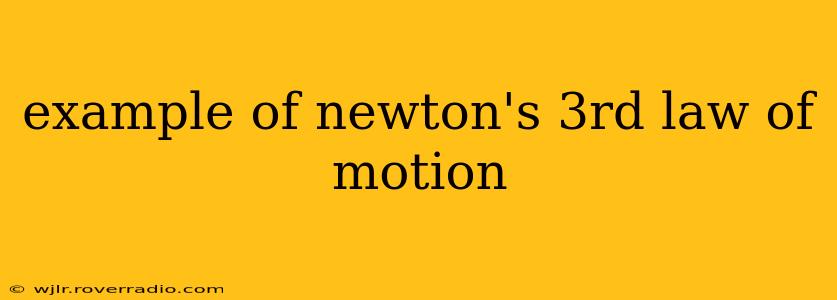Newton's Third Law of Motion, often simplified to "for every action, there's an equal and opposite reaction," describes the fundamental interaction between objects. It's crucial to understand that these "action" and "reaction" forces are always acting on different objects, not on the same object. Let's explore this with several clear examples:
What are some everyday examples of Newton's Third Law?
This is a common question, and the answer lies all around us. Many everyday occurrences illustrate this fundamental principle of physics. Here are some examples:
-
Walking: When you walk, you push backward on the ground (action). The ground, in turn, pushes forward on your feet with an equal and opposite force (reaction), propelling you forward. Without this reaction force from the ground, you wouldn't be able to move.
-
Swimming: Swimmers propel themselves through the water by pushing backward on the water (action). The water, in response, exerts an equal and opposite force forward on the swimmer (reaction), enabling them to move forward.
-
Jumping: When you jump, you push down on the Earth (action). Simultaneously, the Earth pushes up on you with an equal and opposite force (reaction), launching you into the air. The Earth's immense mass means this upward force is barely noticeable to the planet, but it's crucial to your upward movement.
How does Newton's Third Law apply to rockets?
Rocket propulsion is a prime example of Newton's Third Law. Rockets expel hot gas downwards (action) – this is the thrust. The gas, in reaction, exerts an equal and opposite upward force on the rocket (reaction), propelling it upwards. The greater the force of the expelled gas, the greater the upward thrust on the rocket.
What about a car accelerating?
A car accelerates forward by pushing backward on the road through its wheels (action). The road then pushes forward on the wheels with an equal and opposite force (reaction), causing the car to move forward. This is friction between the tires and the road playing a critical role. On ice, where friction is reduced, this reaction force is smaller, making acceleration difficult.
Does Newton's Third Law apply to all forces?
Yes, Newton's Third Law applies to all forces, whether they are gravitational, electromagnetic, or contact forces. Every force is part of an action-reaction pair. For example, the force of gravity pulling an apple towards the earth is countered by an equal and opposite force of the apple pulling on the earth (though this effect is negligible because of the earth's massive size).
Are action and reaction forces always equal and opposite in magnitude?
Yes, absolutely. This is the essence of Newton's Third Law. The forces are always equal in magnitude and opposite in direction. This is true regardless of the objects involved and the type of force.
Why don't action and reaction forces cancel each other out?
This is a common misconception. While the forces are equal and opposite, they act on different objects. Therefore, they cannot cancel each other out. The action force acts on one object, and the reaction force acts on a different object, leading to a net change in momentum for each.
This exploration of Newton's Third Law showcases its universal applicability and explains some common misunderstandings. It's a fundamental principle that underpins our understanding of motion and interaction in the universe.
